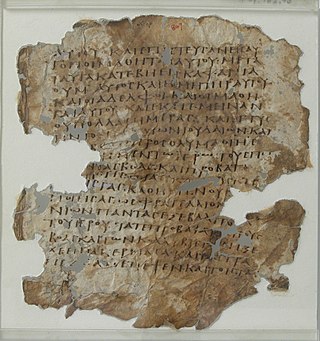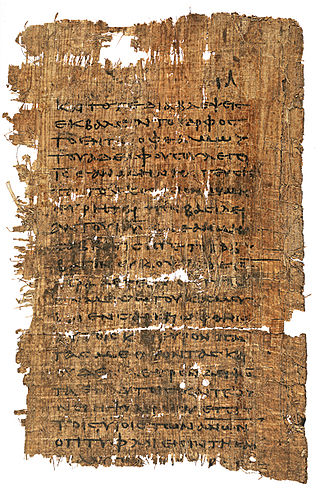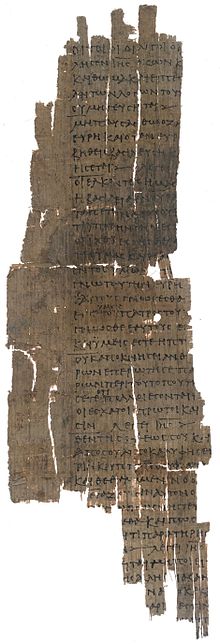
Uncial 0162, ε 023, is one vellum leaf of a Codex containing The Gospel of John in Greek. It has been paleographically assigned a 3rd or 4th century CE date.

The Oxyrhynchus Papyri are a group of manuscripts discovered during the late nineteenth and early twentieth centuries by papyrologists Bernard Pyne Grenfell and Arthur Surridge Hunt at an ancient rubbish dump near Oxyrhynchus in Egypt.

Papyrus Oxyrhynchus 1 is a papyrus fragment of the logia of Jesus written in Greek. It was among the first of the Oxyrhynchus Papyri discovered by Grenfell and Hunt. It was discovered on the second day of excavation, 12 January 1897, in the garbage mounds in the Egyptian town of Oxyrhynchus. The fragment is dated to the early half of the 3rd century. Grenfell and Hunt originally dated the fragment between 150 and 300, but "probably not written much later than the year 200." It was later discovered to be the oldest manuscript of the Gospel of Thomas.

Papyrus Oxyrhynchus 16 is a fragment of the fourth book of the History of the Peloponnesian War by Thucydides in Greek. It was discovered by Grenfell and Hunt in 1897 in Oxyrhynchus. The fragment is dated to the first century. It is housed in the University of Pennsylvania Museum. The text was published by Grenfell and Hunt in 1898.
Papyrus Oxyrhynchus 53 is a report on a persea tree, written in Greek. The manuscript was written on papyrus in the form of a sheet. It was discovered by Grenfell and Hunt in 1897 in Oxyrhynchus. The document was written on 25 February 316. It is housed in the British Museum. The text was published by Grenfell and Hunt in 1898.

Papyrus Oxyrhynchus 655 is a papyrus fragment of the logia of Jesus written in Greek. It is one of the Oxyrhynchus Papyri discovered by Grenfell and Hunt between 1897 and 1904 in the Egyptian town of Oxyrhynchus. The fragment is dated to the early 3rd century. It is one of only three Greek manuscripts of the Gospel of Thomas.

Nag Hammadi Codex II is a papyrus codex with a collection of early Christian Gnostic texts in Coptic. The manuscript has survived in nearly perfect condition. The codex is dated to the 4th century. It is the only complete manuscript from antiquity with the text of the Gospel of Thomas.
Papyrus Oxyrhynchus 90 is a receipt for the payment of wheat, written in Greek. The manuscript was written on papyrus in the form of a sheet. It was discovered in the Egyptian city of Oxyrhynchus. The document was written between 179-180. Currently it is housed in the British Museum (761) in London. It is known also as P. Lond. 3 p. XXXII no. 761.
Papyrus Oxyrhynchus 91 is a receipt for wages for wet nursing, written in Greek. The manuscript was written on papyrus in the form of a sheet. It was discovered in Oxyrhynchus. The document was written on 13 October 187. Currently it is housed in the library of the Royal Holloway College in Egham.
Papyrus Oxyrhynchus 92 is an order for payment, written in Greek. The manuscript was written on papyrus in the form of a sheet. It was discovered in Oxyrhynchus. The document was written on 15 October 336. Currently it is housed in the Houghton Library of Harvard University in Cambridge.
Papyrus Oxyrhynchus 93 is an order for payment, written in Greek. The manuscript was written on papyrus in the form of a sheet. It was discovered in Oxyrhynchus. The document was written on 16 January 362. Currently it is housed in the British Museum (762) in London.
Papyrus Oxyrhynchus 94 is an agreement for the sale of two slaves, written in Greek. It was discovered in Oxyrhynchus. The manuscript was written on papyrus in the form of a sheet. The document was written on 26 October 83. Currently it is housed in the British Museum (763) in London.
Papyrus Oxyrhynchus 95 is an agreement for the sale of a slave, written in Greek. It was discovered in Oxyrhynchus. The manuscript was written on papyrus in the form of a sheet. The document was written on 23 June 129. Currently it is housed in the library of the Royal Holloway College in Egham.
Papyrus Oxyrhynchus 96 is an order concerning payment of sales tax, written in Greek. It was discovered in Oxyrhynchus in Egypt. The manuscript was written on papyrus in the form of a sheet. The document was written on 5 November 180. Currently it is housed in the Cambridge University Library in Cambridge.
Papyrus Oxyrhynchus 97 is a power of attorney, agreed on between two brothers. It is written in Greek, and was discovered in Oxyrhynchus. The manuscript was written on papyrus in the form of a sheet. The document was written between January–February of the year 116. Currently it is housed in the Edinburgh University Library in Edinburgh.
Papyrus Oxyrhynchus 98 is a letter acknowledging the repayment of a loan, written in Greek. It was discovered in Oxyrhynchus. The manuscript was written on papyrus in the form of a sheet. It is dated to between 141 and 142. Currently it is housed in the British Museum (764) in London. It is also known as P. Lond. III 764.
Papyrus Oxyrhynchus 210 is an early Christian fragment, written in Greek. It was discovered in Oxyrhynchus. The manuscript was written on papyrus in the form of a codex. It is dated to the third century. Currently it is housed in the Cambridge University Library (4048) in Cambridge.
Papyrus Oxyrhynchus 232 is a fragment of Contra Timocratem by Demosthenes, written in Greek. It was discovered in Oxyrhynchus. The manuscript was written on papyrus in the form of a roll. It is dated to the second or third century. Currently it is housed in the British Library in London.
Papyrus Oxyrhynchus 265 is a fragment of a Marriage Contract, in Greek. It was discovered in Oxyrhynchus. The manuscript was written on papyrus in the form of a sheet. It is dated to 81-96. Currently it is housed in the Thomas Fisher Rare Book Library of the University of Toronto in Toronto.
Papyrus Oxyrhynchus 267 is a fragment of an Agreement of Marriage in Greek. It was discovered in Oxyrhynchus. The manuscript was written on papyrus in the form of a sheet. It is dated to 22 May 37. Currently it is housed in the Milton S. Eisenhower Library of the Johns Hopkins University in Baltimore.






